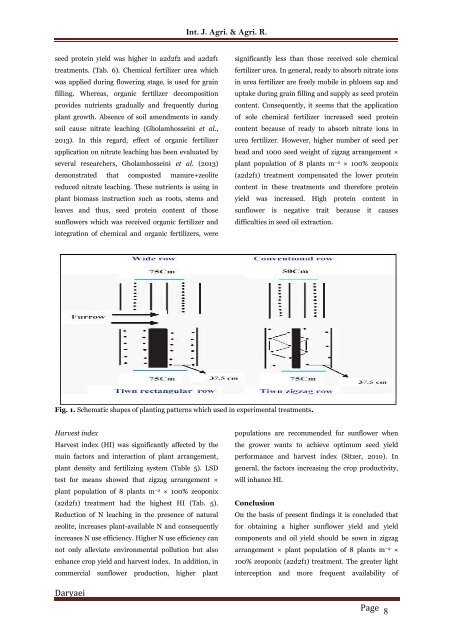Effect of planting pattern, plant density and integration of zeoponix and chemical fertilizer (urea) on sunflower yield and yield components
An experiment was conducted to evaluate the effect of planting pattern, plant density and integration of zeoponix and chemical N fertilizer (urea) on sunflower yield and yield components. The experimental design was analyzed as factorial based on randomized complete block with three replications. Treatments consisted of 3 factors which are different crop densities, including 2 levels. The population of plants was including 5 plants m–2 (d1) and 8 plants m–2 (d2). The second factor was planting patterns which were included twin rectangular rows (A1) and twin zigzag rows (A2). Different fertilizing treatments were selected as third factor consisted of the sole application of zeoponix (f1) and chemical fertilizer urea (f3), and integration of 50%zeoponix +50% chemical fertilizer urea (f2), that were at 3 levels. Results showed that there were significant differences in interaction of planting pattern, plant density and fertilizing system on plant height, stalk diameter, biologic yield, seed yield, number of seeds per head, 1000 seed weight, seed oil content and oil yield, protein content and protein yield and harvest index. LSD test for means of these traits showed that zigzag arrangement × plant population of 8 plants m–2 × 100% zeoponix (a2d2f1) treatment had the best performance and could be recommended to farmers for sunflower cultivation. Get the full articles at: http://www.innspub.net/volume-7-number-6-december-2015-ijaar/
An experiment was conducted to evaluate the effect of planting pattern, plant density and integration of zeoponix and chemical N fertilizer (urea) on sunflower yield and yield components. The experimental design was analyzed as factorial based on randomized complete block with three replications. Treatments consisted of 3 factors which are different crop densities, including 2 levels. The population of plants was including 5 plants m–2 (d1) and 8 plants m–2 (d2). The second factor was planting patterns which were included twin rectangular rows (A1) and twin zigzag rows (A2). Different fertilizing treatments were selected as third factor consisted of the sole application of zeoponix (f1) and chemical fertilizer urea (f3), and integration of 50%zeoponix +50% chemical fertilizer urea (f2), that were at 3 levels. Results showed that there were significant differences in interaction of planting pattern, plant density and fertilizing system on plant height, stalk diameter, biologic yield, seed yield, number of seeds per head, 1000 seed weight, seed oil content and oil yield, protein content and protein yield and harvest index. LSD test for means of these traits showed that zigzag arrangement × plant population of 8 plants m–2 × 100% zeoponix (a2d2f1) treatment had the best performance and could be recommended to farmers for sunflower cultivation. Get the full articles at: http://www.innspub.net/volume-7-number-6-december-2015-ijaar/
Create successful ePaper yourself
Turn your PDF publications into a flip-book with our unique Google optimized e-Paper software.
Int. J. Agri. & Agri. R.<br />
seed protein <strong>yield</strong> was higher in a2d2f2 <str<strong>on</strong>g>and</str<strong>on</strong>g> a2d2f1<br />
treatments. (Tab. 6). Chemical <str<strong>on</strong>g>fertilizer</str<strong>on</strong>g> <str<strong>on</strong>g>urea</str<strong>on</strong>g> which<br />
was applied during flowering stage, is used for grain<br />
filling. Whereas, organic <str<strong>on</strong>g>fertilizer</str<strong>on</strong>g> decompositi<strong>on</strong><br />
provides nutrients gradually <str<strong>on</strong>g>and</str<strong>on</strong>g> frequently during<br />
<str<strong>on</strong>g>plant</str<strong>on</strong>g> growth. Absence <str<strong>on</strong>g>of</str<strong>on</strong>g> soil amendments in s<str<strong>on</strong>g>and</str<strong>on</strong>g>y<br />
soil cause nitrate leaching (Gholamhosseini et al.,<br />
2013). In this regard, effect <str<strong>on</strong>g>of</str<strong>on</strong>g> organic <str<strong>on</strong>g>fertilizer</str<strong>on</strong>g><br />
applicati<strong>on</strong> <strong>on</strong> nitrate leaching has been evaluated by<br />
several researchers, Gholamhosseini et al. (2013)<br />
dem<strong>on</strong>strated that composted manure+zeolite<br />
reduced nitrate leaching. These nutrients is using in<br />
<str<strong>on</strong>g>plant</str<strong>on</strong>g> biomass instructi<strong>on</strong> such as roots, stems <str<strong>on</strong>g>and</str<strong>on</strong>g><br />
leaves <str<strong>on</strong>g>and</str<strong>on</strong>g> thus, seed protein c<strong>on</strong>tent <str<strong>on</strong>g>of</str<strong>on</strong>g> those<br />
<strong>sunflower</strong>s which was received organic <str<strong>on</strong>g>fertilizer</str<strong>on</strong>g> <str<strong>on</strong>g>and</str<strong>on</strong>g><br />
<str<strong>on</strong>g>integrati<strong>on</strong></str<strong>on</strong>g> <str<strong>on</strong>g>of</str<strong>on</strong>g> <str<strong>on</strong>g>chemical</str<strong>on</strong>g> <str<strong>on</strong>g>and</str<strong>on</strong>g> organic <str<strong>on</strong>g>fertilizer</str<strong>on</strong>g>s, were<br />
significantly less than those received sole <str<strong>on</strong>g>chemical</str<strong>on</strong>g><br />
<str<strong>on</strong>g>fertilizer</str<strong>on</strong>g> <str<strong>on</strong>g>urea</str<strong>on</strong>g>. In general, ready to absorb nitrate i<strong>on</strong>s<br />
in <str<strong>on</strong>g>urea</str<strong>on</strong>g> <str<strong>on</strong>g>fertilizer</str<strong>on</strong>g> are freely mobile in phloem sap <str<strong>on</strong>g>and</str<strong>on</strong>g><br />
uptake during grain filling <str<strong>on</strong>g>and</str<strong>on</strong>g> supply as seed protein<br />
c<strong>on</strong>tent. C<strong>on</strong>sequently, it seems that the applicati<strong>on</strong><br />
<str<strong>on</strong>g>of</str<strong>on</strong>g> sole <str<strong>on</strong>g>chemical</str<strong>on</strong>g> <str<strong>on</strong>g>fertilizer</str<strong>on</strong>g> increased seed protein<br />
c<strong>on</strong>tent because <str<strong>on</strong>g>of</str<strong>on</strong>g> ready to absorb nitrate i<strong>on</strong>s in<br />
<str<strong>on</strong>g>urea</str<strong>on</strong>g> <str<strong>on</strong>g>fertilizer</str<strong>on</strong>g>. However, higher number <str<strong>on</strong>g>of</str<strong>on</strong>g> seed per<br />
head <str<strong>on</strong>g>and</str<strong>on</strong>g> 1000 seed weight <str<strong>on</strong>g>of</str<strong>on</strong>g> zigzag arrangement ×<br />
<str<strong>on</strong>g>plant</str<strong>on</strong>g> populati<strong>on</strong> <str<strong>on</strong>g>of</str<strong>on</strong>g> 8 <str<strong>on</strong>g>plant</str<strong>on</strong>g>s m –2 × 100% <str<strong>on</strong>g>zeop<strong>on</strong>ix</str<strong>on</strong>g><br />
(a2d2f1) treatment compensated the lower protein<br />
c<strong>on</strong>tent in these treatments <str<strong>on</strong>g>and</str<strong>on</strong>g> therefore protein<br />
<strong>yield</strong> was increased. High protein c<strong>on</strong>tent in<br />
<strong>sunflower</strong> is negative trait because it causes<br />
difficulties in seed oil extracti<strong>on</strong>.<br />
Fig. 1. Schematic shapes <str<strong>on</strong>g>of</str<strong>on</strong>g> <str<strong>on</strong>g><str<strong>on</strong>g>plant</str<strong>on</strong>g>ing</str<strong>on</strong>g> <str<strong>on</strong>g>pattern</str<strong>on</strong>g>s which used in experimental treatments.<br />
Harvest index<br />
Harvest index (HI) was significantly affected by the<br />
main factors <str<strong>on</strong>g>and</str<strong>on</strong>g> interacti<strong>on</strong> <str<strong>on</strong>g>of</str<strong>on</strong>g> <str<strong>on</strong>g>plant</str<strong>on</strong>g> arrangement,<br />
<str<strong>on</strong>g>plant</str<strong>on</strong>g> <str<strong>on</strong>g>density</str<strong>on</strong>g> <str<strong>on</strong>g>and</str<strong>on</strong>g> fertilizing system (Table 5). LSD<br />
test for means showed that zigzag arrangement ×<br />
<str<strong>on</strong>g>plant</str<strong>on</strong>g> populati<strong>on</strong> <str<strong>on</strong>g>of</str<strong>on</strong>g> 8 <str<strong>on</strong>g>plant</str<strong>on</strong>g>s m –2 × 100% <str<strong>on</strong>g>zeop<strong>on</strong>ix</str<strong>on</strong>g><br />
(a2d2f1) treatment had the highest HI (Tab. 5).<br />
Reducti<strong>on</strong> <str<strong>on</strong>g>of</str<strong>on</strong>g> N leaching in the presence <str<strong>on</strong>g>of</str<strong>on</strong>g> natural<br />
zeolite, increases <str<strong>on</strong>g>plant</str<strong>on</strong>g>-available N <str<strong>on</strong>g>and</str<strong>on</strong>g> c<strong>on</strong>sequently<br />
increases N use efficiency. Higher N use efficiency can<br />
not <strong>on</strong>ly alleviate envir<strong>on</strong>mental polluti<strong>on</strong> but also<br />
enhance crop <strong>yield</strong> <str<strong>on</strong>g>and</str<strong>on</strong>g> harvest index. In additi<strong>on</strong>, in<br />
commercial <strong>sunflower</strong> producti<strong>on</strong>, higher <str<strong>on</strong>g>plant</str<strong>on</strong>g><br />
populati<strong>on</strong>s are recommended for <strong>sunflower</strong> when<br />
the grower wants to achieve optimum seed <strong>yield</strong><br />
performance <str<strong>on</strong>g>and</str<strong>on</strong>g> harvest index (Sitzer, 2010). In<br />
general, the factors increasing the crop productivity,<br />
will inhance HI.<br />
C<strong>on</strong>clusi<strong>on</strong><br />
On the basis <str<strong>on</strong>g>of</str<strong>on</strong>g> present findings it is c<strong>on</strong>cluded that<br />
for obtaining a higher <strong>sunflower</strong> <strong>yield</strong> <str<strong>on</strong>g>and</str<strong>on</strong>g> <strong>yield</strong><br />
comp<strong>on</strong>ents <str<strong>on</strong>g>and</str<strong>on</strong>g> oil <strong>yield</strong> should be sown in zigzag<br />
arrangement × <str<strong>on</strong>g>plant</str<strong>on</strong>g> populati<strong>on</strong> <str<strong>on</strong>g>of</str<strong>on</strong>g> 8 <str<strong>on</strong>g>plant</str<strong>on</strong>g>s m –2 ×<br />
100% <str<strong>on</strong>g>zeop<strong>on</strong>ix</str<strong>on</strong>g> (a2d2f1) treatment. The greater light<br />
intercepti<strong>on</strong> <str<strong>on</strong>g>and</str<strong>on</strong>g> more frequent availability <str<strong>on</strong>g>of</str<strong>on</strong>g><br />
Daryaei<br />
Page 8


















